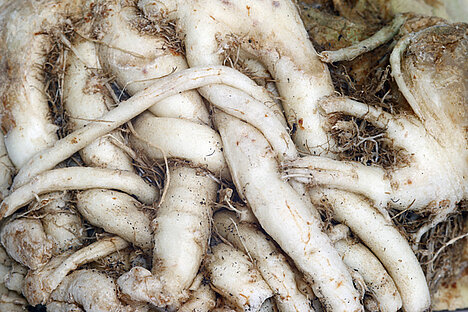Roots

What are roots?
Roots are the thickened storage organs of plants that grow underground. They usually contain a lot of starch, sugar and fiber, but also vitamins, minerals and secondary plant substances. There are many different types of roots, such as carrots, turnips, parsnips, sweet potatoes and celery.
What are the benefits of roots for dogs?
Roots can have some health benefits for dogs if they are fed in moderation. For example, they can:
- Aid digestion, as they contain fiber that stimulates the intestines and improves fecal consistency.
- Clean teeth, as they produce a mechanical abrasion when chewed, which reduces plaque and tartar.
- Strengthen the immune system as they contain vitamins such as A, C and K as well as antioxidants that fight free radicals and inhibit inflammation.
- Regulate weight as they are low in calories but provide a feeling of satiety.
- Stabilize blood sugar levels, as they have a low glycemic index that does not cause blood sugar levels to rise sharply.
What are the disadvantages of roots for dogs?
Roots are not suitable for all dogs and can also have some disadvantages if they are fed too often or too much. For example, they can:
- Trigger allergies or intolerances if the dog is sensitive to certain ingredients. This can manifest itself in skin problems, itching, diarrhea or vomiting.
- It can also cause flatulence or digestive problems if the dog swallows too much air or does not digest the fiber well. This can lead to abdominal pain, gas or constipation.
- Cause an overdose of vitamin A if the dog eats too many carrots. This can lead to symptoms of intoxication such as loss of appetite, weight loss, fatigue or bone damage.
- Impair the absorption of other nutrients if the dog eats too many roots and therefore has less room for other foods. This can lead to deficiency symptoms such as anemia, hair loss or weakness.
What is the best way to feed roots?
If you want to feed your dog roots, there are a few things you should bear in mind:
- Choose fresh and organic roots that do not contain harmful substances or pesticides.
- Wash the roots thoroughly and cut them into small pieces or grate them finely. This way you avoid the risk of suffocation or injury to the mouth.
- Boil the roots briefly in water or steam them lightly. This makes them softer and easier to digest. Raw roots can also be fed, but only in small quantities and as a treat between meals.
- Mix the roots with your dog's normal food or add them as a side dish. This ensures a balanced diet and avoids overfeeding.
- Only feed as much root as your dog can tolerate and observe his reaction to it. If you notice any signs of discomfort, reduce the amount or omit the roots altogether.
Roots can be a tasty and healthy addition to your dog's diet if you choose, prepare and dose them correctly. Try it out and find out which roots your dog likes best!
If you notice any signs of hypersensitivity or poisoning in your dog, you should see your vet immediately. We are not a substitute for a vet, but we try to be as accurate as possible. Every dog reacts differently and we recommend you get a second opinion or consult your vet if in doubt.
Stay healthy and take good care of your four-legged friend!😊